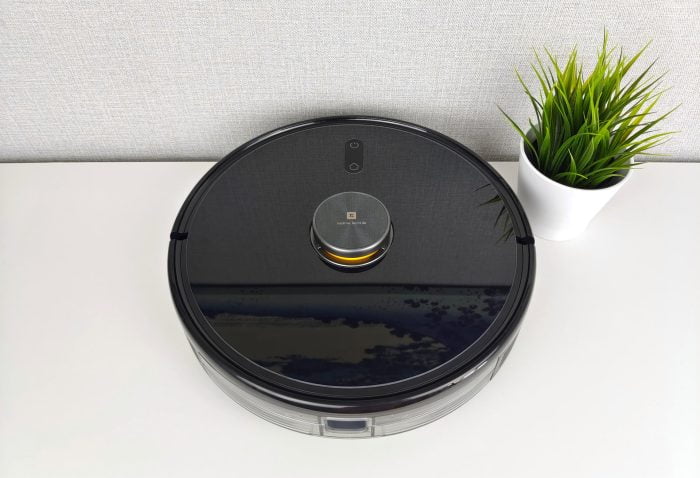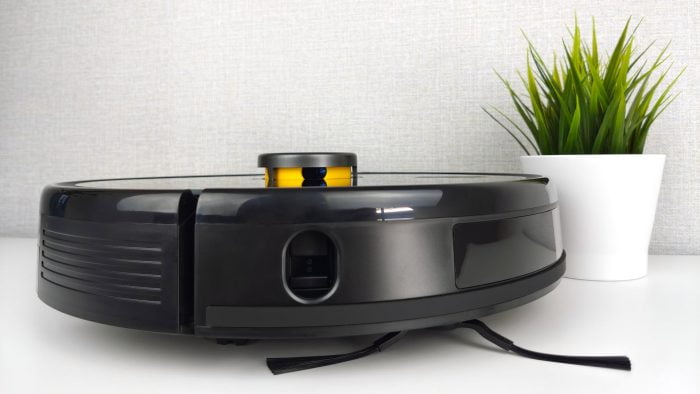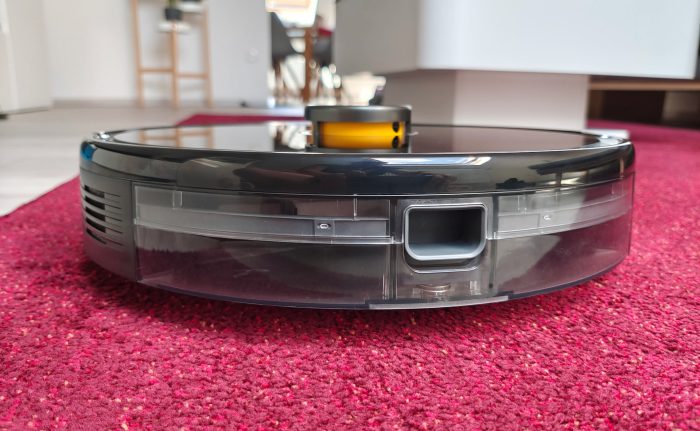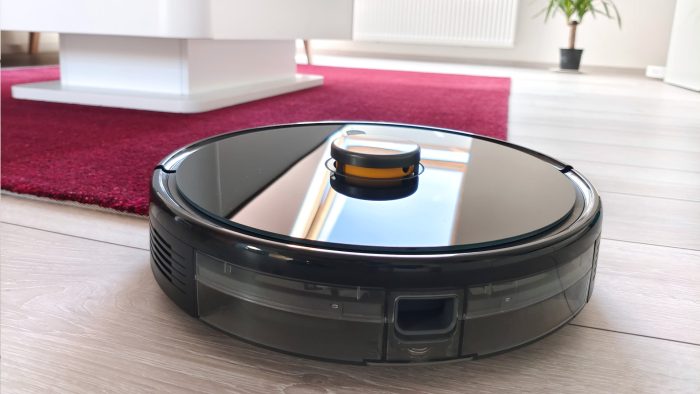realme TechLife Robot Vacuum
At the end of 2020, realme Europe CEO Madhav Sheth announced that realme would also get involved in the IoT segment in 2021. Realme is already represented in the home market of China and India with smart sockets, televisions, body analysis scales and many other IoT and smart home products.
The first Smart Life products have also appeared in this country, but the selection is rather modest in comparison. It is now all the more interesting that realme has released a vacuum robot that is also available for European customers.
Design, workmanship and delivery
In terms of design, the realme TechLife vacuum robot hardly differs from other models of its kind. The round housing has a diameter of 35 cm and is 10 cm high. So it corresponds in size to one Roborock S7. With a weight of 3,3 kg, the vacuum robot is one of the lighter models.
Most of the housing parts are made of plastic. For the top cover plate, however, the decision was made to use break- and scratch-resistant glass. It looks chic, but over time, fingerprints and dust settle there, which can hardly be overlooked on the high-gloss surface.
The LiDAR tower is located in the middle of the top. The cover is adorned with the realme logo and the realme TechLife lettering. The rotating part of the laser tower, which is kept in typical real yellow, sets a colored accent. A power and a home button are also located on the top. Both buttons are illuminated and covered with rubber for protection.
In addition to the LiDAR tower, the realme vacuum robot is provided with a total of 38 sensors. Obstacles are recognized with the help of the side (infrared) sensors. The vacuum robot uses a pressure-sensitive bumper that is aligned in the direction of travel to approach obstacles in the immediate vicinity.
The dust container is not inserted over the top, but on the side. The high capacity of 600 ml offers enough space for dirt from several suction processes. A HEPA filter in the dust container prevents fine dust from being released into the ambient air.
The underside also hardly differs from other vacuum robots. There we would have the fall sensors, the drive wheels and a guide wheel, the two contact surfaces for loading and the removable main brush with V-shaped bristles and a rubber lip. For the side brushes, realme decided not only for one, but for two. This makes it easier for the vacuum robot to get into the corners.
In terms of processing quality, the realme TechLife vacuum robot can keep up with the competition. Nothing wobbles and in terms of wear and tear, there are no abnormalities after several suction processes.
The scope of delivery is clear. In addition to the robot vacuum cleaner, it also includes a typical tool with a brush and blade for removing hair, a replacement filter, the charging station with power supply unit and operating instructions. If you also want to use the realme vacuum robot for mopping, the "Mopping Kit", consisting of a water container and wiping cloths, has to be purchased. This is a shame, because with other manufacturers it goes without saying that the wiping equipment is included in the scope of delivery.
Setup and app
To set up the realme robot vacuum cleaner, the "realme Link" app and a realme user account are required. The app can be downloaded free of charge from the respective app stores (Android and iOS). All realme Smart Life products, from fitness wristbands and headphones to surveillance cameras, are managed via the app. If you click on “Add device” within the app, various realme products are suggested for a connection.
In the test, the app recognized the realme vacuum robot directly. The necessary setup steps are understandable and uncomplicated. Basically, you only have to transmit your own WLAN data so that the vacuum robot is integrated into the home network (only 2.4 GHz). Then enter a name for the vacuum robot and the device is ready to go.
The structure of the app is clear. The home page presents the cleaning map, including the room layout and the current route, provided the vacuum robot is currently vacuuming. The cleaning task (location, area, room and car) can be specified below the map. In addition to a return-to-home button, there is a start button, a button for setting the suction power (quiet, normal, turbo and max) and a button for accessing the other settings. Above the card you can find useful information about the completed cleaning area, the cleaning time and the remaining battery.
It is possible to define cleaning profiles in the settings. The profiles depend on the time, suction power, water level and cleaning area. The "do not disturb mode" ensures that the speech output remains mute. Other functions include a virtual remote control, a find function, an auto boost for carpets and settings for voice and volume. The voice output is limited to Chinese, English female voice and English children's voice.
The card management gives you access to the stored cards (maximum 5). This is particularly useful when there are several floors so that the vacuum robot does not have to create a new room map every time. The room map is divided into individual rooms that can be separated or combined using the app. Restricted zones can be drawn or marked on the map in the form of “no-go zones” and “no-wipe zones”. The “virtual wall”, which can also be drawn anywhere on the map, prevents the vacuum robot from crossing the drawn line.
Incidentally, the vacuum robot can also be integrated into the smart home. There is already a skill for Amazon's Alexa and an interface for Google Home.
field test
suction
With a suction force of 3000 Pa, the realme vacuum robot is one of the more powerful models on the market. However, it only achieves this at the "Max" suction level. In the "Turbo" the suction force is 2500 Pa. In the "Normal" mode, which is active by default, the suction force is 1200 Pa. Coarse and fine dirt can easily be vacuumed from hard floors in this mode.
For carpets, we recommend the Turbo, which is automatically activated when the Auto-Boost function is active. That worked flawlessly in the test. However, one should note that the real me vacuum robot can only handle heels up to 1,5 cm. The vacuum robot likes to get stuck on higher carpet edges and deep pile. After several unsuccessful attempts to free yourself, the suction process is paused and the error is signaled via the voice output.
If you want it to be particularly quiet, you can choose the "Quiet" mode. In this mode the suction force is reduced to 500 Pa. The volume is indeed low at only 55 dB. But even in the "Normal" mode, the robot vacuum goes to work with a (still) comfortable volume at which you can talk.
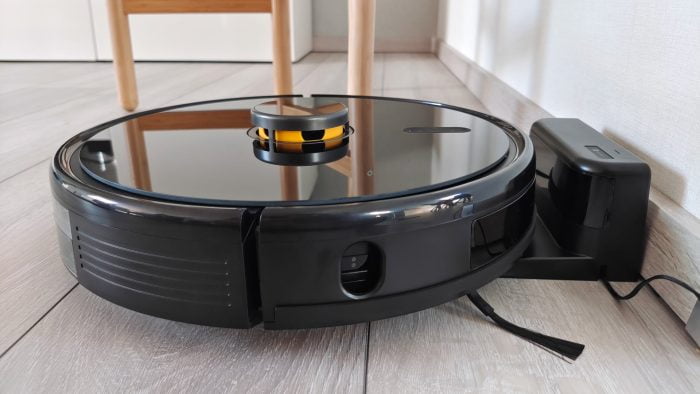
After a daily cleaning drive, there is very little need to help with the handheld vacuum cleaner, because the two side brushes reach into the corners. Hair gets caught in the V-shaped roller brush less often than in a conventional roller brush. Should a hair get caught anyway, it can be easily pulled out, because the V-shaped arrangement also prevents hairs from being pulled tight.
The cleaning of the 600 ml dust container is done quickly. Pull out, tap out, rinse under water and reinsert.
Navigate
The accuracy of the navigation is in no way inferior to comparable models. The LiDAR technology has proven itself over the years.
If you send the realme vacuum robot on its cleaning tour for the first time, the surroundings are first explored extensively and recorded on a map. The first cleaning trip takes on average a little longer than further trips. It is not uncommon for the vacuum robot to only partially clean a room on its first trip, to take care of the next and then continue cleaning in the first room.
The vacuum robot needed 65 minutes for 75 m² and then only 65 minutes. This is because rooms are approached more specifically on all further journeys and cleaned in one go. The accuracy of the map created is good. Only one hallway was divided into two parts in the test. Such room sections are quickly connected to one room via the app.
The realme vacuum robot carefully approaches obstacles. He slowly approaches table and chair legs and moves around them at their edge, if there is enough space. Particularly flat obstacles, such as cables, coasters or clothes lying around, are mercilessly run over. This is not atypical. Almost every vacuum robot without sonar or (stereo) camera has to struggle with it. The fall sensor system precisely detects stairs.
wiping function
Fortunately, our test device was delivered including the "mopping kit". The tank is a so-called 2-in-1 system that combines a 300 ml dust container with a 350 ml water container. This enables the robot vacuum cleaner to vacuum and mop at the same time.
Water is filled into the water tank through a side opening. The dust container is plugged into the tank separately and, like the standard dust container, has a HEPA filter. A water pump integrated in the container enables 4-stage water delivery. The app can be used to set in which room and with what amount of water is dispensed. To prevent damp carpets, you should definitely define “no-wipe zones” via the app.
The robotic vacuum cleaner simply pulls the microfiber wipe behind it. Realme opted for two wipe patterns so that the wiping function is still reasonably usable. The "S-shaped path" saves electricity. The "Y-shaped path" is intended to simulate manual cleaning with a mop and thereby increase the cleaning effect.
The wiping function itself is good, but does not replace manual wiping. In particular, the contact pressure that is built up when wiping by hand does not arise here. The wiping function is not sufficient for stubborn dirt and limescale stains.
Battery
The battery of the realme TechLife vacuum robot has a capacity of 5200 mAh. This is the common standard in this price range. In "Turbo" mode, the robot hoover achieves a running time of approx. 130 minutes with just one charge. That is enough for the complete cleaning of an area of 180 m². If you switch to "Normal" or "Quiet" mode, the running time is extended to up to 300 minutes. A full charge takes approximately 6 hours.

realme TechLife Robot Vacuum
Good workmanship
Easy commissioning
Clear app
High suction power
Quiet operation
Large dust container
Long-lasting battery
Mopping kit not included
Doesn't stand out from other models
Small bugs here and there
The processing quality is right, the cleaning performance is good, the battery lasts a long time and the navigation is largely unobjectionable. To what extent it is justified to offer the mopping kit as a purchasable feature is debatable.
Realme's first vacuum robot is definitely not a failure and does not have to hide from the competition! Nevertheless, the realme TechLife Robot Vacuum Cleaner is above all a swimmer in its price range, because there are no innovative functions that take it to another level.

